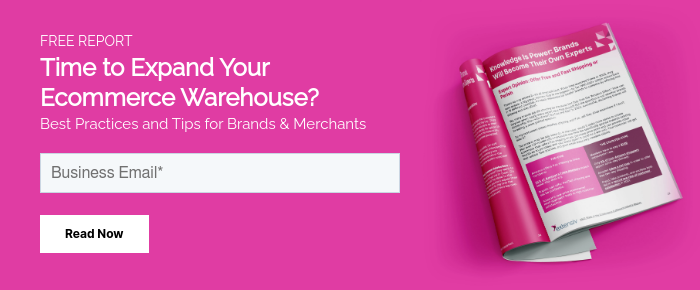Where do you think people are searching for products these days?
It’s not Google anymore – it’s Amazon, the largest product search engine in the US. From hand-knitted gloves to household appliances, it’s the first place that everyone looks when they need to shop around, price a product, and make a purchase.
And it makes sense – these days Amazon’s algorithm will come back with so many products fitting your search description, all compared by price, that you just have to choose your favorite one and click “buy”, making it one of the most streamlined way to shop online.
What does that mean for you as a seller?
Frankly, if you’re selling goods online and you’re not on Amazon, you’re missing out on one of the largest consumer networks in the world.
Get this – it doesn’t even matter what kind of goods you sell.
Do you deal in niche, artisan products? There’s a good chance that your niche buyers already shop on Amazon, so don’t just keep selling through Shopify – these days you can integrate Shopify with Amazon for the best of both worlds.
Do you sell products that appeal to a wider audience? Try an audience of well over 300 million customers actively buying goods on Amazon, the third-largest retailer in the world.
There’s no doubt that the market potential of Amazon for any seller is enormous. With so many buyers using the platform as their go-to place to shop online, finding customers isn’t the problem. The problem is:
How are your customers going to find you?
It will come as no surprise that with such huge selling opportunities comes a lot of competition among sellers dying to rank their products high and make it on the first page of Amazon, where the majority of sales are made.
If you’re not ranking on the first page, odds are the buyers will find what they need before scrolling through any more pages and your products will sit there gathering dust.
What are you up against?
I’m not going to lie to you – you’re going to start off as a small fish in a big pond. Other sellers are racking up reviews and using automated software to keep their prices competitive with those around them – but they started off exactly where you are now, and they made it.
How?
Two words. Product ranking. Here’s what you need to do.
Make the Algorithm Happy

If you want to get your products on the first page, you need to become best friends with A9, Amazon’s algorithm. It takes things into account like:
- Prices: High? Low? Fair? The algorithm will put you next to your competitors and figure that out.
- Inventory: How many products are we talking here? The more you stock, the more seriously you’re taken as a seller.
- Reviews: Amazon wants to see good reviews in large quantities. The best thing you can do here is provide great customer service and help your customers with whatever they need.
- Click-through rates: If someone finds a product of yours, do they read the details? Do they check out your other products, or turn their nose up and leave? It matters.
- Customer sales history: Sounds unfair? Well, the better quality buyers you attract, the higher your seller authority is!
- Sales volume: This is a bit of a chicken-and-the-egg-type situation, but once you get things moving this will become more important for ranking even higher. More sales, higher ranking. Higher ranking, more sales!
- Amazon Fulfillment (FBA) for Prime Customers: That’s something Amazon definitely like to see, and is actually considered to be by far one of the largest factors in ranking.
Finally, super important:
- Product title and keyword.
That’s a huge aspect of ranking high on Amazon. You need to choose the right kind of keywords to help customers find your products. Choosing keywords based on market data to rank higher on a search engine is called Search Engine Optimization, or SEO.
If you haven’t heard of that, well… you’re about to! And it’s a fundamental aspect of promoting any content online, your products included.
Optimize your listings
Three things you need to optimize your product listings:
- SEO Keyword Research
- Choose the right images
- Marketable pricing
Amazon SEO
Let’s start with SEO. There are tools you can use to research which keywords will help rank your products higher on Amazon’s algorithm, and we’ll get to those in a minute.
Here’s the thing – Amazon SEO isn’t the same as Google’s SEO at all. Whereas Google wants to provide the most relevant information, Amazon’s algorithm is designed to sell products.
That’s it.
Whichever products are likely to sell go straight to the top – a buyer could search for one thing and end up coming across a different product that the algorithm thinks they’re likely to purchase, even if it’s not what they were originally looking for.
Amazon’s goal is to maximize the revenue per customer (RPC), and their algorithm is designed with that in mind. Everything is analyzed and accounted for – key word trends, click through rates – even where a customer’s mouse hovers longest on a page. It’s all fed back into the algorithm to optimize things for greater RPC.
So how can you optimize your listings to help boost your ecommerce operations?
What you want to do is choose keywords with low “competition” – competition here refers to how much money is being spent on advertising including these words.
If the competition is high, you’re not going toe-to-toe with huge corporations trying to rank with those keywords as well.
Take a look at the following two searches – one of them yields 8000 results, while the other only yields 103, far less search competition than the first.
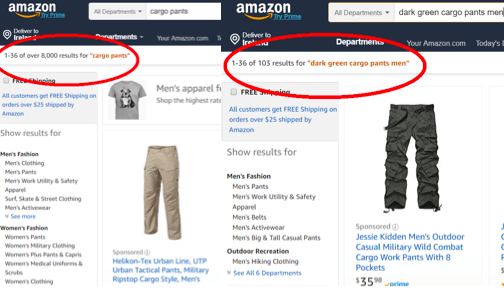
It’s definitely best to avoid competing with groups that spend millions of dollars on SEO and advertising - unless you plan on spending the same!
The smart move is to go with “long-tail” keywords.
Long-tail keywords are highly specific keyword phrases of 2-5 words that people enter into the search engine when they’re looking for products. Long-tail keywords aren’t searched for as often as their counterparts at the “head”, which are more concise and sought-after keywords – but then, competition for those is very stiff, and you’d need to spend a fortune on advertising to even try to make it work.
The good news is, it’s not necessary! The search volume for long-tail keywords is still high enough to direct customers to your product listings. As seen in the graph below, the more descriptive the phrase, the better. Four word phrases are often a good call.
Choosing the right keywords
Don’t worry, there are tools that can make this a very straightforward process. Some of them are free, like Google Keyword Planner. Amazon listings will of course use the Amazon search engine, not Google, but the words people search for will usually be the same, and because it’s a free tool, it’s a great introduction to keyword research. You’ll need a Google Adwords account to use it, and that’s free too.
To setup Google ads for Amazon, first sign up for Google Adwords and click on the wrench icon on the top right, then click on “keyword planner”.
Let’s say you’re selling cargo pants, and you want to optimize your Amazon listing. Remember: you want words that people looking to buy your kind of products are already entering into the search engine, that’s the goal.
Select “search for new keywords” at the top, put in your product description, “cargo pants”, and click “get ideas”.
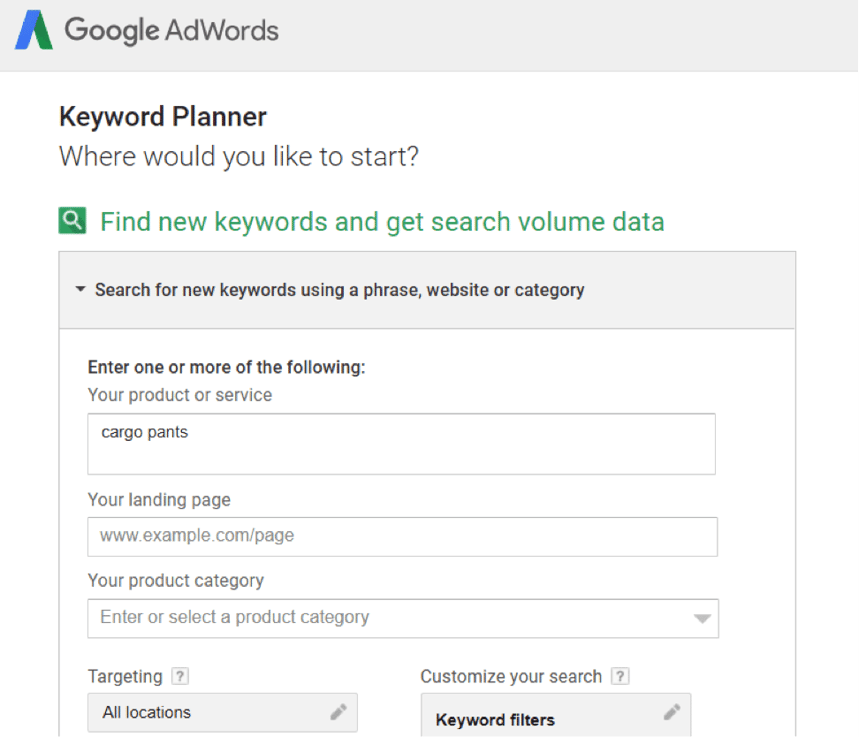
Here’s what you’ll see:
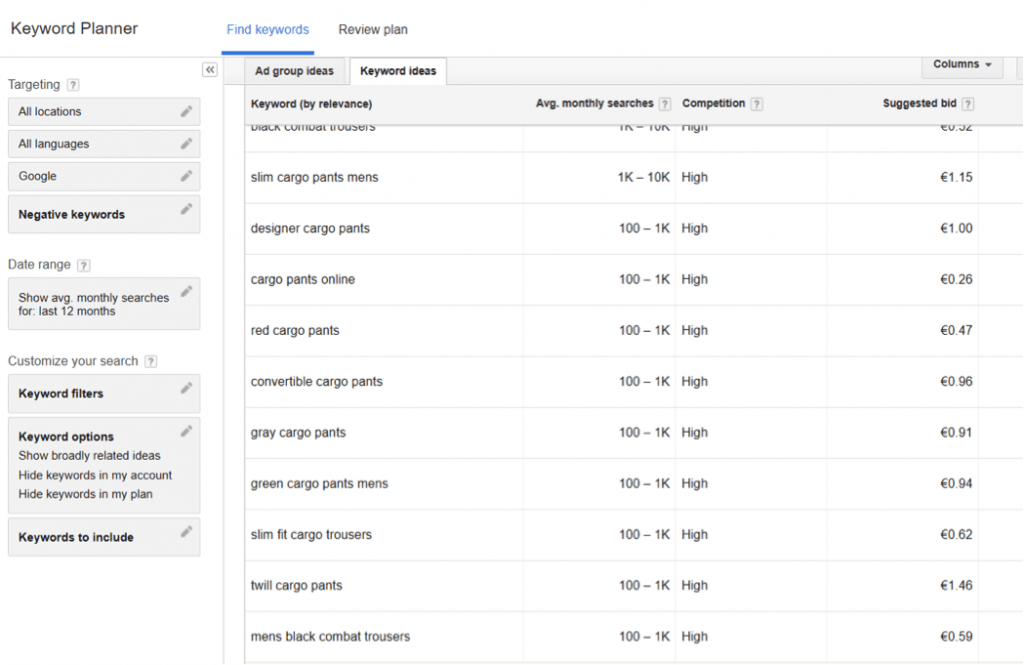
These are the phrases people searching for cargo pants are entering into Google.
There are some long tail phrases, but they all have high competition. If you click “competition” twice, you can sort by order of low competition.
Doing that, we can see that “dark green cargo pants men” has a long tail phrase with 10-100 searches a month and medium competition.
If you’re selling cargo pants that match this description and you use these keywords, you may only get 10-100 people actively searching a month, but because you have exactly what they want, they’re more likely to find your product and make a purchase.
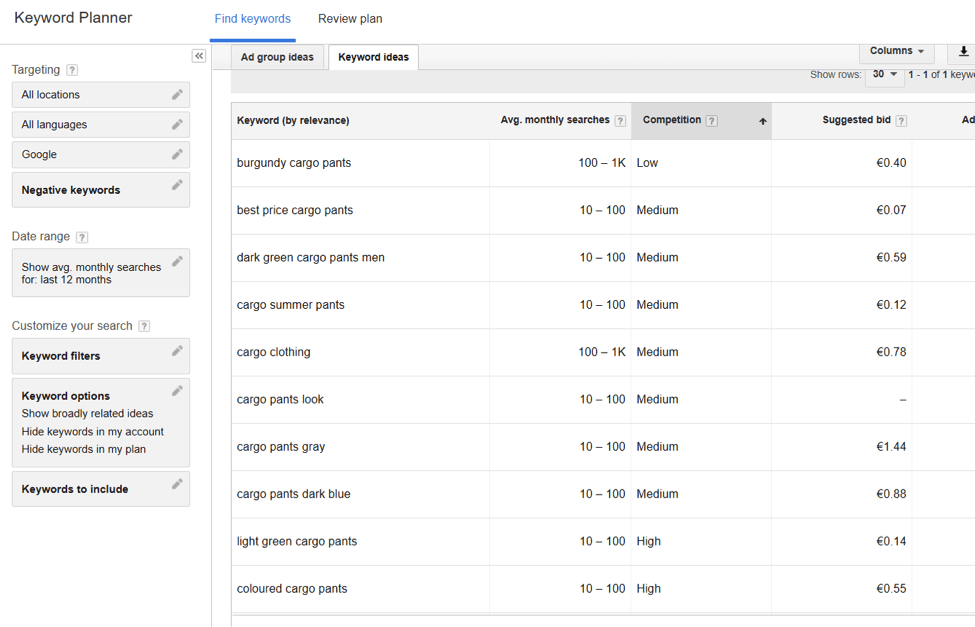
Other tools you can use are Moz, which has free and paid options, and Scope, a paid Google Chrome extension that performs a variety of Amazon-specific functions.
Scope allows you to perform a reverse ASIN search, meaning you can analyze your competitors’ search data, exporting product keyword search volumes to show what it is that people who buy top-selling products are searching for.
You can also learn estimated sales per keyword and average CPC (cost per click) bids, - that’s all really great stuff if you’re trying to plan new listings and optimize them.
Using your keywords wisely
Good Amazon SEO strategy dictates that you should optimize for three things:
Visibility, relevance, and conversions.
Relevance is important. You don’t need to jam as many keywords in the title just for the sake of it, and descriptions that are too keyword-heavy can result in penalties.
Do it like this:
Title your product accurately in a user-friendly way. Yes, your keyword will probably be there, but phrase it naturally.
Include some long-tail keywords in the product description, and make that well-written and to the point. Bullet-pointed information is a good format that does well on Amazon.
Finally, backend description – now, this area you can jam full of keywords, and you should. This description isn’t seen by site visitors, just read by the algorithm to help link the right products to the right customers.
The more long-tail keywords you have in here that accurately describe your product, the better, and you have 1000 characters compared to the 500 characters available in the main description area.
If you’re not confident in your writing abilities, don’t be afraid to hire a professional copywriter who specializes in Amazon listings (yes, that’s a thing).
Choose the right images

Amazon’s algorithm favors listings with at least four or five good quality images, so make sure that your listing includes different photographs of your product.
Good quality here means high resolution – customers want to be able to zoom in and get a good look at what they’re buying. This also helps to deter fraudsters from simply posting a single image that doesn’t represent their product.
There’s a long list of technical requirements, but the bones of it is that the images should represent what you sell, be clear, in focus, and of a high quality.
Marketable prices
To make your prices attractive to customers and appealing to the algorithm, you need to find your floor price, the lowest price you can go to while still making enough money to cover costs and generate a profit.
Don’t worry if that doesn’t sound like fun – profits on Amazon are usually generated through volume of sales over time, not necessarily from high markups on individual products. Optimize those listings and your products fly out the door and you’ll start to see the profits you’ve been hoping for.
How do you calculate floor price? First, consider your costs.
Shipping, customs, FBA, customer returns, Amazon commission – think about all the overhead costs you’ll incur and incorporate that into your pricing strategy.
Your “upper floor” refers to how high you can go – it’s not advisable to charge more than 20% higher than page one competitors.
Go as low as you can without shooting yourself in the foot and the algorithm will decide that you’re selling at a competitive rate that will make *Amazon* money, which makes Amazon happy, meaning they rank you higher, which makes *you* happy – that’s how it works.
What Amazon wants is to generate sales – the algorithm favors whatever makes buyers happy and whatever prompts them to buy more products, and it’s good to bear that fundamental motivation in mind.
Make your decisions with an aim to help Amazon make money, and you’ll put yourself in a good position to rank high and make money yourself.
Speaking of which…
Generate Sales
Here’s the thing. Starting a business on Amazon is a little like flying an airplane - it’s all good when you’re in the air, but the starting phases are delicate, to say the least!
First, you need to prepare for lift off. Here’s where some marketing will come in especially handy. You could use your new-found Google Adwords skills to plan and launch a campaign through Google.
You could also launch an Amazon Sponsored Ads campaign – apart from the obvious benefit of marketing your products, you can actually generate some really useful data from these campaigns as well.
Sponsored ads give you access to a “search term report” which is essentially a treasure trove of customer data useful to any seller (for example, you can enter keywords and see which specific phrases customers are using, and then apply that to your own product listing SEO).
These kind of ad campaigns aren’t the only ways to kickstart your e-commerce venture. You could start publishing content in anticipation of your campaign, building awareness, maybe even prompting readers to sign up for a newsletter for offers – get creative, and build anticipation if you can.
OK, so you’ve been taxiing up the runway, building up speed and momentum – what’s so hard about lift-off?
The tricky thing here is controlling the sales volume, and that essentially comes down to keeping the algorithm happy, as usual.
While it might sound great to sell a large volume on the first day, this can actually hurt your ranking if customers don’t follow through the next day. It’s more important to sell consistently, and it’s also more important that your second day’s sales are equal to or greater than your first day, and the same goes with weeks, etc.
Once you’ve been selling a little while, it’s not as important – every business has its ups and downs.
However, it’s important to carefully manage the “lift-off” stage those first few days and sell generating consistent sales. If you use a campaign to build awareness, you can use timed offers to keep customers coming in, and an email list to send a newsletter to would come in particularly useful there.
Sales Ranking
Let’s look a little more closely at the rankings in general.
Individual products can compete for the best seller ranking. This is arguably a little more hyped up than it may deserve, and is essentially a rating of how many units have been sold in the last hour.
The more recently with that hour a product has sold, the higher it ranks – you can see the different best sellers in each category here.
While it’s an envious title that can certainly help boost sales, it’s not a perfect system, and it actually registers things like free kindle book downloads as “sales”, which can throw things off a little.
If your product ranks high on the best seller ranking (aka sales ranking), happy days – if not, don’t worry about it. Focus on good business practices and great product listings instead. Ad campaigns can boost your visibility, but so will running your business well.
In fact, while ad campaigns are great for your paid ranking, there’s another type of ranking to consider – organic sales ranking.
You rank high organically by simply optimizing and pricing your products well and having customers find you through that merit. Organic sales ranking is increased when a buyer searches for a product, finds what they’re looking for, and makes a purchase.
This is called search/click/purchase behavior. If a buyer searches for a keyword, clicks on a sponsored ad, and buys as a result, that increases your organic sales ranking as well, and this type of ranking is better for your business in the long run than paid ranking generated solely from customers clicking on ads without searching for anything.
It’s free, sustainable, and the algorithm favors sellers who rank high organically better in the long run.
And we know by now that we want to stay in the algorithms good books, don’t we!
We do.
I think that about covers it!
Feeling good? Feeling overwhelmed?
It’s a lot to take in if you’re new to selling on Amazon. Maybe it seems a little scary, maybe it seems like a lot of fuss.
It might motivate you to learn that Amazon accounted for 43% of all online sales in 2016, a figure expected to increase over time. 1.6 million packages are shipped every day – that’s the market.
Wouldn’t you like some of those packages to be your packages?
It’s a great time to get in on the action, so if you think it sounds right for you, go for it.
With a little preparation, planning, and bargaining with the almighty algorithm, you’ll have a great e-commerce venture up and running in no time on the largest online retail platform in the world.
What to remember

Optimize your listings with SEO and high res photos.
Use online tools to find long-tail keywords to help customers find your listings.
Build anticipation for your products via content marketing and/or ad campaigns.
If in doubt – leave it to the professionals! Don’t be shy when it comes to hiring a professional copywriter, photographer, or online services that can help manage and optimize your sales channels.
Here’s a video from our E-commerce TV Channel series describing some specific examples of ranking products on Amazon.
